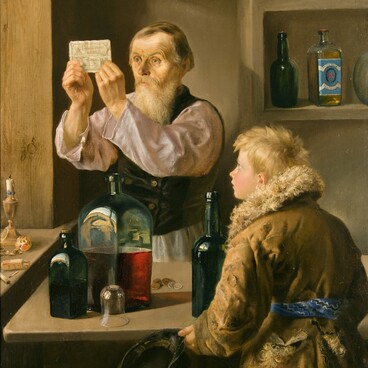Vasily Nikiforovich Bovin was a portraitist, genre and icon painter. The artist was born in the city of Morshansk, Tambov province. In the 1830s, Bovin received an art education at Alexander Stupin’s Arzamas School of Painting. In 1839, based on the results of his studies, he received a silver medal from the Imperial Academy of Arts, and in 1840 — the title of a non-class portrait painter. Vasily Nikiforovich is buried at the Smolensk Orthodox Cemetery in St. Petersburg.
The main exhibition of the Voronezh Regional Art Museum includes a genre scene by Vasily Nikiforovich. In front of the viewer is the interior of one of the richest houses in St. Petersburg. Through the open door, one can see the open doors to two more rooms. The hostess of the house is standing on the threshold, witnessing a scene that was not intended for her eyes: her husband is courting a pretty young milkmaid.
A fourth character is watching the same scene through the crack of the door from the first room. There are few people in this scene, but the artist manages to convey the strong, somewhat diametrically opposite emotions experienced by them at the moment: rejection of what is happening, mixed with helplessness, in the pose and face of the girl; the determination of the owner of the house; shock and indignation in the appearance of his wife; and joyful anticipation of the development of events in the character secretly watching the scene. One of the main features of the painting is the depth of the composition. The canvas is divided into four consecutive plans, with the help of which the artist invites the viewers to enter the depicted interior, to become a witness, and perhaps a hero of the story unfolding before their eyes.
The work created by the artist belongs to the everyday genre, which flourished in Russian art in the second half of the 19th century. At that time, the artists turned to the folk life and work of people of the common class. The main feature of genre art is the embedded story, fragments of everyday reality, which often became objects of irony and satire.
The brightest representative of genre art is the
English painter and engraver William Hogarth. The artist became famous
throughout Europe thanks to a series of engravings in which exciting stories
worthy of film adaptation unfolded. Hogarth’s most famous plot, “A Harlot’s
Progress” (1732), included six engravings about the story of a young girl, Moll
Hackabout, who arrived in London from the country.


